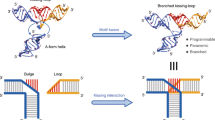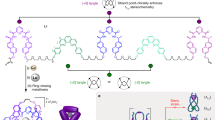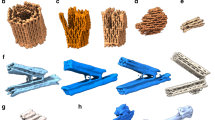Abstract
A PRINCIPAL goal of biotechnology is the assembly of novel biomaterials for analytical, industrial and therapeutic purposes. The advent of stable immobile nucleic acid branched junctions1–4 makes DNA a good candidate for building frameworks to which proteins or other functional molecules can be attached and thereby juxtaposed5–7. The addition of single-stranded 'sticky' ends8 to branched DNA molecules converts them into macromolecular valence clusters that can be ligated together1. The edges of these frameworks are double-helical DNA, and the vertices correspond to the branch points of junctions. Here, we report the construction from DNA of a covalently closed cube-like molecular complex containing twelve equal-length double-helical edges arranged about eight vertices. Each of the six 'faces' of the object is a single-stranded cyclic molecule, doubly catenated to four neighbouring strands, and each vertex is connected by an edge to three others. Each edge contains a unique restriction site for analytical purposes. This is the first construction of a closed polyhedral object from DNA.
This is a preview of subscription content, access via your institution
Access options
Subscribe to this journal
Receive 51 print issues and online access
$199.00 per year
only $3.90 per issue
Buy this article
- Purchase on Springer Link
- Instant access to full article PDF
Prices may be subject to local taxes which are calculated during checkout
Similar content being viewed by others
References
Seeman, N. C. J. theor. Biol. 99, 237–247 (1982).
Seeman, N. C. & Kallenbach, N. R. Biophys J. 44, 201–209 (1983).
Kallenbach, N. R., Ma, R.-I. & Seeman, N. C. Nature 305, 829–831 (1983).
Seeman, N. C. J. Biomol. Str. Dyns 3, 11–34 (1985).
Robinson, B. H. & Seeman, N. C. Prot. Engn. 1, 295–300 (1987).
Hopfield, J. J., Onuchic, J. N. & Beratan, D. N. Science 241, 817–820 (1988).
Chen, J.-H., Kallenbach, N. R. & Seeman, N. C. J. Am. chem. Soc. 111, 6402–6407 (1989).
Cohen, S. N., Chang, A. C. Y., Boyer, H. W. & Helling, R. B. Proc. natn. Acad. Sci. U.S.A. 70, 3240–3244 (1973).
Seeman, N. C. J. biomol. Str. Dyns 8, 573–581 (1990).
Seeman, N. C. J. biomol. Str Dyns 5, 997–1004 (1988).
Wang, J. C. Proc. natn. Acad. Sci. U.S.A. 76, 200–203 (1979).
Rhodes, D. & Klug, A. Nature 286, 573–578 (1980).
Williams, R. The Geometrical Foundation of Natural Structure (Dover, New York, 1979).
Wells, A. F. Three-dimensional Nets and Polyhedra (Wiley, New York, 1977).
Caruthers, M. H. in Chemical and Enzymatic Synthesis of Gene Fragments (eds Gassen, H. G. & Lang, A.) 71–79 (Verlag Chemie, Weinheim, 1981).
Author information
Authors and Affiliations
Rights and permissions
About this article
Cite this article
Chen, J., Seeman, N. Synthesis from DNA of a molecule with the connectivity of a cube. Nature 350, 631–633 (1991). https://doi.org/10.1038/350631a0
Received:
Accepted:
Issue Date:
DOI: https://doi.org/10.1038/350631a0
This article is cited by
-
Rational design of metal-responsive functional DNA supramolecules
Journal of Inclusion Phenomena and Macrocyclic Chemistry (2024)
-
Generation of DNA oligomers with similar chemical kinetics via in-silico optimization
Communications Chemistry (2023)
-
Throwing and manipulating and cheating with a DNA nano-dice
Nature Communications (2023)
-
Storage of mechanical energy in DNA nanorobotics using molecular torsion springs
Nature Physics (2023)
Comments
By submitting a comment you agree to abide by our Terms and Community Guidelines. If you find something abusive or that does not comply with our terms or guidelines please flag it as inappropriate.



